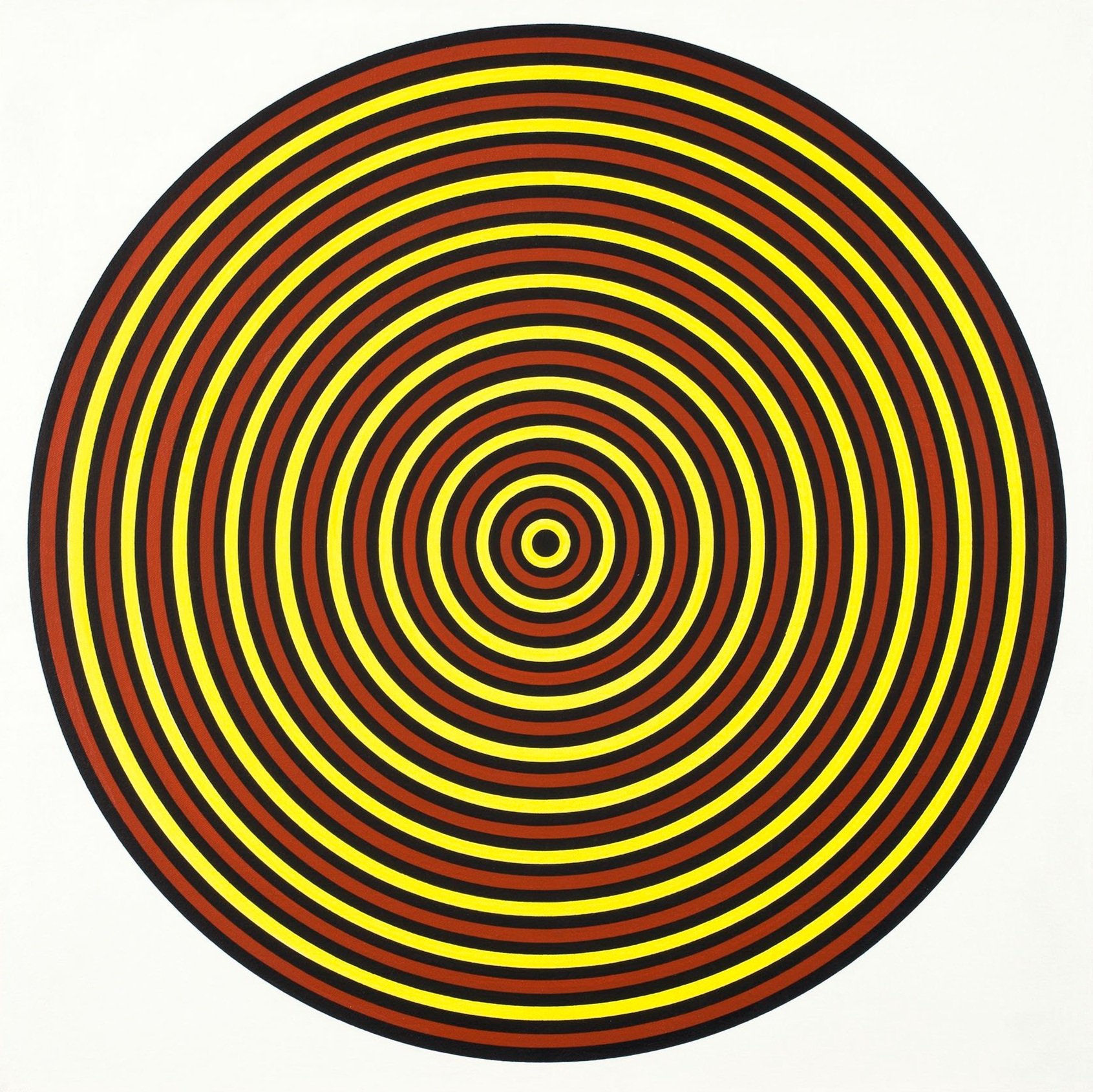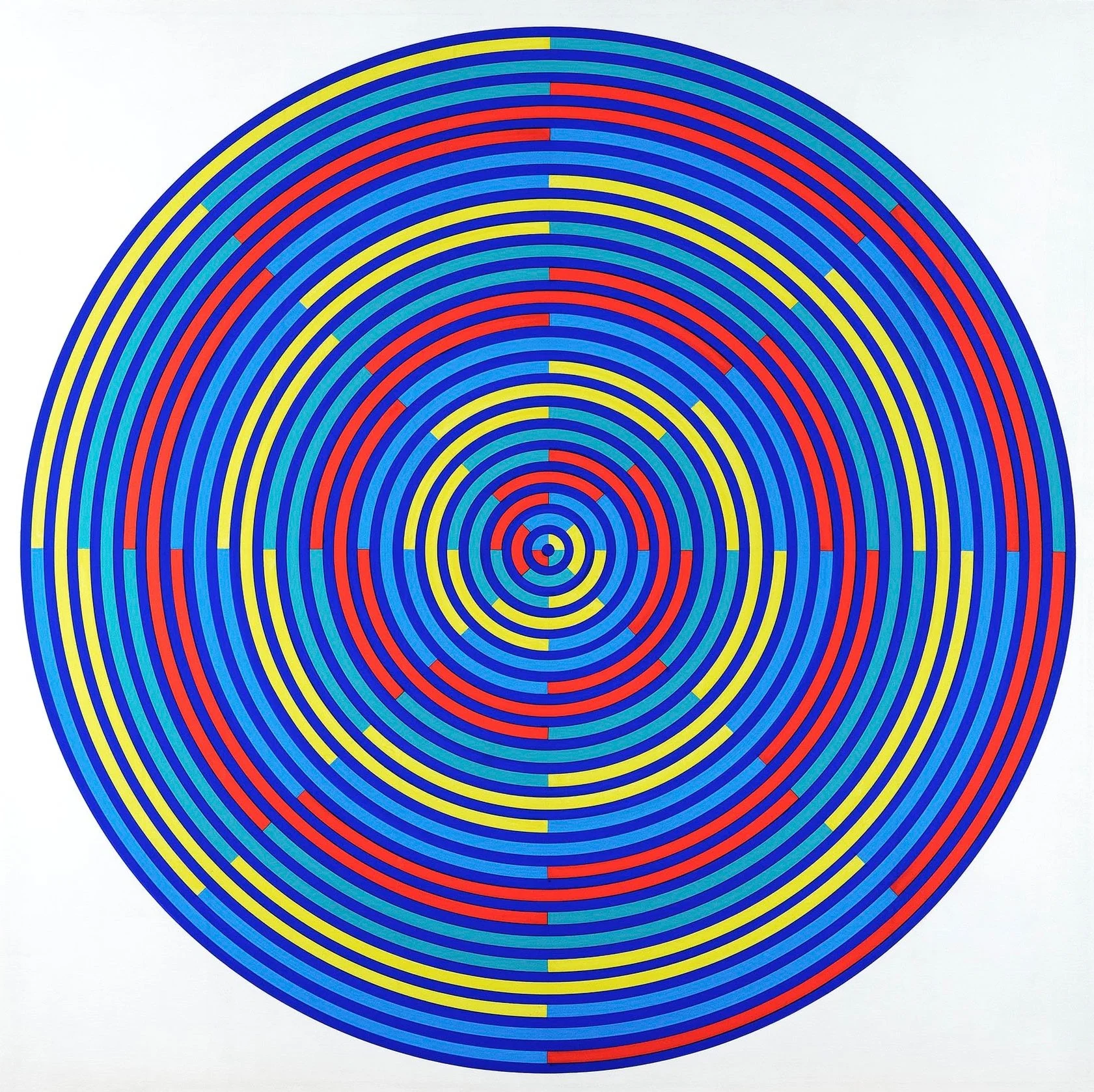TADASKY (b. 1935)
Available Work | Biography | New York Times Review
Biography • Tadasky (b. 1935)
Tadasky in his Ferry St. studio, 1964.
Tadasky (Tadasuke Kuwayama) was born in Nagoya, Japan. He painted since childhood, but as a youngster was steered toward his father’s business of shrine-building. This led him to study applied engineering at university in Tokyo and learn the craft of miyadaiku (shrine carpenters) in the family factory. Tadasky taught himself about modern and Western art from books. His eyes were opened to the power of abstraction through the work of Josef Albers and other Bauhaus artists; art made up of simple squares and other geometric elements was essentially prohibited in the Japanese art tradition. In Japan, Tadasky experimented with many forms of art, including representational painting, but by the time he applied for scholarships to the United States, he was experimenting with simple circles in larger constructions.
Tadasky came to the United States in 1961 on a scholarship to study at the Cranbrook Academy of Art in Bloomfield Hills, Michigan. Tadasky’s first stop was New York where he decided to stay. He soon won a modern art scholarship competition at the Art Students League and the prize of free tuition enabled him to stay in New York and rent a studio loft in which he worked. At this time, Tadasky sustained himself financially with carpentry work. Tadasky then received a scholarship from the Brooklyn Museum art school to work in his own studio in Manhattan, rather than attend classes, after impressing the director with his paintings.
In the early 1960s, Tadasky began to focus on compositions of concentric circles that trigger color interaction and explore sensory stimulation. These compositions are highly calculated and precisely created, consisting of thin, pulsating, vibrantly colored lines that seem to whirl and radiate outward from the center. Shortly after arriving in New York, Tadasky set out to create tools that would aid him to create the perfect rings he envisioned. Through painstaking experimentation in his studio, Tadasky developed a special wheel for his circles and adapted it into a drum for vertical lines. For brushwork, he used traditional Japanese brushes best suited to the fine detail of his paintings.
In 1964 the Museum of Modern Art purchased A-101, 1964, as well as B-171, 1964, for its permanent collection. A-101 appeared in the December 11, 1964 edition of Life magazine in an article titled “Op Art: A dizzying fascinating style of painting.” Other museums soon followed, including the Baltimore Museum of Art; the Albright-Knox Art Gallery (Seymour Knox purchased 3 works); the Museum of Fine Arts, Houston; and the Phoenix Art Museum. Tadasky was included in the Museum of Modern Art's exhibition The New Japanese Painting and Sculpture in 1966, which travelled to the San Francisco Museum of Art, the Denver Art Museum, and the Milwaukee Art Museum, among others. In Japan, Tadasky's work was acquired by the Ohara Museum of Art in Kurashiki, the Nagoya City Art Museum, and the Museum of Contemporary Art in Nagaoka, as well as the Gutai Pinacotheca in Osaka. Private collectors included Harry Abrams, Frederick Weisman, David Rockefeller, and James Michener.
Sam Kootz visited Tadasky’s studio loft in 1964 and offered him a solo exhibition at the Kootz Gallery, where Tadasky had his first solo exhibition in January 1965 and again in October of that year. Tadasky went on to have solo exhibitions in Japan in 1966 at the Tokyo Gallery, Tokyo and at the Gutai Pinacotheca, Osaka followed by two solo exhibitions in New York at Fischbach Gallery in 1967 and 1969. In 1969 Tadasky and Gene Davis had a joint exhibition at the Closson's Art Gallery in Cincinnati, Ohio.
Tadasky participated in seminal Op Art exhibitions including the Museum of Modern Art’s The Responsive Eye and the Albright-Knox Art Gallery’s Kinetic and Optic Art Today, both in 1965. He was included in the prestigious annual Shusakuten exhibition in Tokyo in 1966, and in the Japanese National Museum of Art's exhibition Japanese Artists Abroad the same year. Tadasky’s bright, multicolored compositions were an instant success with the public; in 1968, Springbok Editions manufactured a circular jigsaw titled “Whirling Disks by Tadasky.”
Tadasky’s work was strongly featured in the Columbus Museum of Art’s 2007 exhibition Optic Nerve: Perceptual Art of the 1960s with seven works illustrated in the exhibition catalogue. Tadasky was also included in Extreme Abstraction at the Albright-Knox Art Gallery in 2005. Tadasky’s paintings were included in Resounding Spirit: Japanese Contemporary Art of the 1960s in 2008 organized by the Gibson Gallery at SUNY Potsdam, which traveled to the Spencer Museum of Art at the University of Kansas and the Carleton University Art Gallery, Ottawa, Canada. He also had work in Adapting and Adopting: Waves of Change as East Encounters West in 2012 at the Lowe Art Museum at the University of Miami, Florida. In 2013 the Museum of Modern Art loaned its painting A101, 1964 to the well received Dynamo: a Century of Light and Motion in Art, 1913-2013 at the Grand Palais in Paris. B115, 1964 was recently acquired by the Museo de Arte Contemporáneo Buenos Aires in Argentina and was included in the 2015 exhibition Geometric Obsession — American School 1965 — 2015. Oklahoma City Museum of Art featured Tadasky in Moving Vision: Op and Kinetic Art from the Sixties and Seventies in 2021.
An extensive interview with the artist can be found on Geoform.





